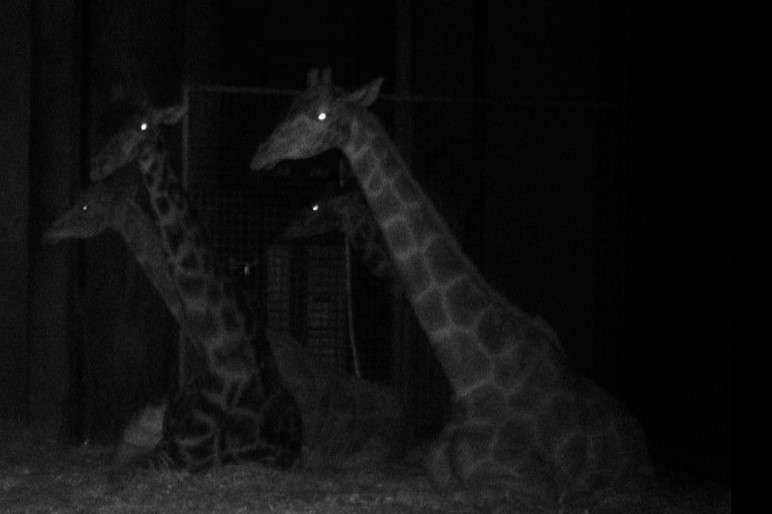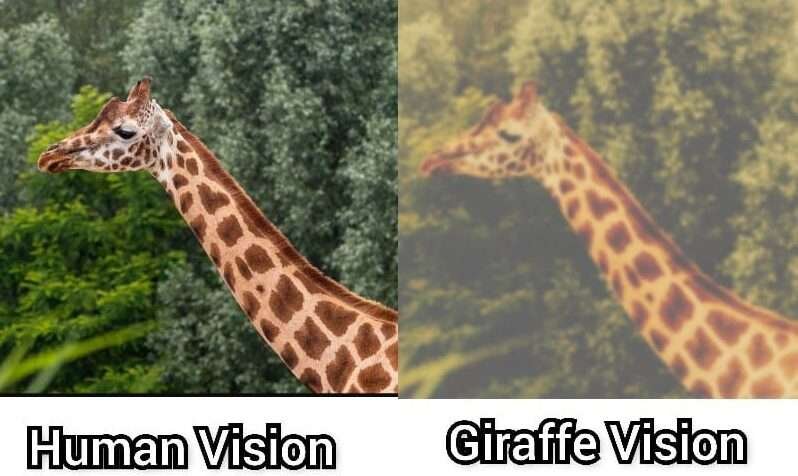A glance at Animal Planet or National Geographic would often show us these long-necked mammals on scrubby grasslands, munching on the leaves of tall acacia trees.
Yes, as most of you have guessed right, I’m talking about the Giraffe. Standing at a height of nearly 17-18 ft, Giraffe is undoubtedly the tallest land animal on planet Earth.
While their long necks have always been a subject of wonder, have you ever thought about what the world would look like from up there? Is a Giraffe’s vision similar to animals and humans, or do these tall magnificent animals have something special?
To answer the question, Giraffe sees the world just like us humans. In fact, they possess colored vision just like us. Giraffes can perceive lights from the visible spectrum, but how many exactly has not been identified so far. Therefore, without much ado, let’s jump on and find out in today’s article of ours, “How do Giraffes see the world? Giraffe’s Vision Explained.“
How do Giraffes see the world?
Giraffes are dichromatic and mostly see the world in blue and yellow shades. According to research papers, giraffes have two types of cone photopigments in their eyes that allows them to glimpse the surrounding primarily in blue, dull-yellow, and gray shades. They share a similar color vision to dogs.
Giraffes’ eyesight is more concentrated on rods than cones. Therefore, like dogs, they have limited color vision and red-green colorblindness. It means they are unable to distinguish green, yellow, orange, and red colors.

In a nutshell, giraffes have an absence of middle and large wavelength cones, and they witness the world with clarity and in less color compared to humans. On the other hand, humans are trichromatic and can perceive the world in blue, green, and red shades from 380 nm to 720 nm wavelength.
In terms of color vision, we are more advanced than giraffes. However, giraffes have supremacy over the night vision. Below we have explained their night vision.
Can Giraffes see in the Dark?
Yes, Giraffes can see in the dark. As justified by The Calgary Zoo, giraffes’ eyes actually glow at night. It signifies they have tapetum lucidum, a thin membrane in their eyes that reflects even the slightest of the light back to the retina, allowing them to see in dim-light conditions.
With the help of the moonlight, they can perceive their environment very well. However, in the complete darkness, giraffes cannot see anything.
A giraffe’s habitat is often shared by ferocious predators like hyenas, lions, and pride of them is capable enough to bring down these humongous animals. Therefore, they need to stay alert from approaching predators.

Credits: The Calgary Zoo (Facebook)
Though their height gives them an added advantage over others, to detect approaching threats easily, things turn a bit different in the dark. Giraffe’s vision might not be as adept as it is in the daytime. This can be understood by their night behavior.
A Giraffe usually relies on visual communication among the members of its herd to keep them together. But at night, thanks to eavesdropping researchers, Giraffes have been found producing a low-frequency humming sound as a means of communication.
They can be heard humming all their way to keep the herd together or to alert the herd from threats. This behavior establishes the fact that their night vision is not as good compared to day vision, making them rely on vocalizations.
Do Giraffes have good eyesight?
A Giraffe’s height always places it at a greater position than all other animals, as it can see large distances compared to others. Giraffes possess an excellent vision. Their large bulging eyes on either side of their head give them a wide peripheral vision.
This panoramic peripheral vision gives them the ability to see eve behind their back. This ability becomes highly beneficial, especially in places like the Savannah, where multiple predators are lurking in the tall grasses. They possess a sharp vision, and can also clearly see objects closer to their eyes, focused.
This comes in handy, especially while feeding, as they feed on thorny bushes, shrubs, or trees. Color vision is found in Giraffes, and their eyes are comparatively larger than most other ungulates (animals with hooves). An adult giraffe possesses binocular vision with greater focus, which helps them to spot predators easily.
How Far can Giraffes See?
The position of a Giraffe’s eyes gives it a clear view of a large area. They can see not only other Giraffes but also predators like lions and hyenas from as far as a kilometer distance.
Giraffes possess an extreme peripheral vision that helps them to gain a panoramic view of the entire surroundings, which sometimes extends even behind them. The more peripheral vision, the greater the area they can see without turning their heads.
Taking a peek into their eyes, we can see the light-sensing cells, rods, and cones arranged in a special manner. This places the Giraffe in an advantageous position, as it helps them to keep a watch on their feet as well as a few meters ahead of it simultaneously while walking.

The ability of Giraffes to spot predators from long distances is often used by other animals which flock near them, especially zebras. Since Zebras and Giraffes share common predators, lions, and hyenas, zebras rely on the latter’s alert call.
This relaxes them to a certain extent, as they now have tall watch-towers to look for approaching predators. The animals, over the years, have learned to comprehend each other’s changes in body posture and behavior, which helps them to react accordingly.
Giraffe Vision vs Human Vision
| Giraffe Vision | Human Vision |
| As stated earlier, Giraffes have extremely good peripheral vision.
Their peripheral vision is panoramic and highly wide-angled, which allows them to even see behind their heads. |
Compared to a Giraffe and also other animals, humans have a very limited peripheral vision.
Human peripheral vision can be roughly estimated to be nearly 100 degrees. |
| In a Giraffe, when born, its vision is mainly monocular and panoramic.
With age, the vision shifts to being more binocular. |
Human vision does not undergo any change from birth to adulthood.
|
| Giraffes change their orbital axis angles. While at birth, their orbital axis is roughly around 73 degrees, which with age gets shifted to roughly 50 degrees. | The human orbital axis angle is roughly around 45 degrees. |
Conclusion
Giraffes are one of the most “surprising” animals on the planet. Despite our huge advances in science and technology, very little has been known about the planet’s tallest animal.
Researchers still fall short of enough information about their anatomy. And within this, their vision falls too. Most of the research on these gigantic beasts has been performed over the last 10 years, yet so little has been known about them.
A major portion of the information we have about them has been collected from captive sources, which do not go in sync with their wild counterparts. Information regarding matters like their night vision has been collected through their behavioral study and is not backed up by any scientific evidence.
Their magnificent size also poses a hindrance to the conduction of research to some extent. However, we can hope and rely on the present generation to explore further into the world of these magnificent animals and unearth some hidden facts about these magnificent creatures.
Here, we conclude our article on “How do Giraffes see the world?” Hope it has managed to feed you with enough information regarding the vision of these “gentle giants.” We will be bringing such informative articles in the future. Until then, stay tuned.
References
Image Source: The Calgary Zoo (Facebook)
Giraffe Vision by Course Hero
Also Read

Meet Abhidept (nickname Monty), the visionary founder of How It See, being an engineering student, he’s fueled by an insatiable curiosity about the world around him. He is captivated by an eclectic correlation between animal groups, science, and nature, and this fascination drives his quest for understanding.
After completing his degree, he’s set on a mission to delve deep into the realm of nature, accumulating knowledge to share with you through his writing. In the meantime, he loves to watch anime and read anime.
